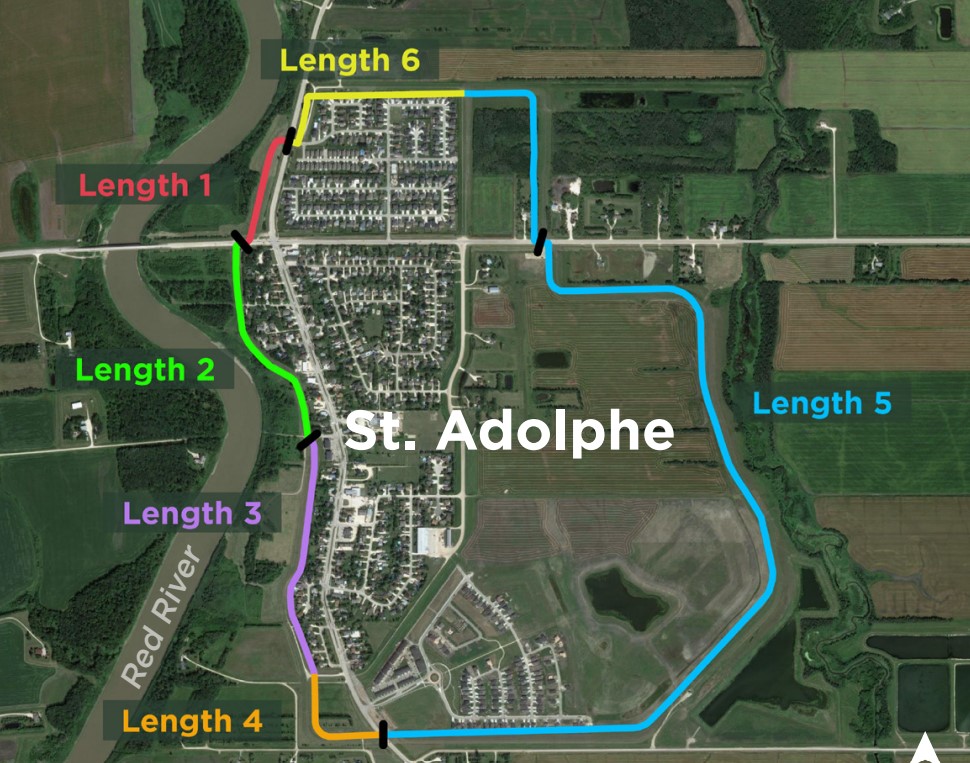St Adolphe gets first look at one-in-200-year flood protection
Advertisement
Hey there, time traveller!
This article was published 25/07/2023 (761 days ago), so information in it may no longer be current.
Ten years after a report recommending Manitoba increase its flood protection in all communities to one-in-200-year events, St Adolphe got its first look at the work being done to raise the 6.9-kilometre dike protecting the town built on a floodplain between two rivers.
The upstairs room at the St Adolphe community centre was filled for two meetings July 17 with rows of residents eager to hear how they will be protected from the rising Red and Seine Rivers, and give their input on what they want their community to look like after the changes.
Ritchot’s St Adolphe councillor Jason Bodnarchuk was impressed with the turnout by his neighbours, and the thoroughness of the presentations by project managers from the Province and contracted builder KGS. He sees opportunity coming along with the heavy earth-moving equipment.

“We’re a very close community, so it’s great to get the input to see what the community wants, like do you want an active transportation system able to be on there, lookout benches, things like that. Those things are a huge benefit to the community because nowadays you see tons of people walking on the dike, and it’d be nice to have a little place to sit down and look over into the fields,” said Coun. Bodnarchuk.
With nearly seven kilometres of dike along the Red River on the western edge of town and stretching over to the Seine in the east, there will be plenty of room to roam and build upon.
But first the work needs to get done.
Surveyors are already out to start on the detailed design phase. Environmental impact considerations and drilling to determine riverbank stabilization work is gearing up. Preliminary work was done last year by KGS.
Dumping thick clay on top of the east dike expansion could start as early as this fall. That segment takes up more than half the dike and was built starting in 2015 to add 390 homes and businesses to the protected area, plus give enough space to more than double the geographical size of the town.
Despite being built two years after the report saying Manitoba needed to build to one-in-200-year scenarios, it was built to the 1997 requirement of one-in-100-year flood events. But it was designed in a way that expected top-ups, which will make it easier to add the extra couple feet of dirt. There is also a small piece built at that time to the one-in-200-year standard by Provincial Road 200 at the south end of town.
While the Province and KGS can move the earth as early as this fall on the eastern and southern ends near the Seine and Leblanc Road, the rest of the work will likely be done in segments that will not be completed until 2029 to optimize efficiency and federal funding grants.
The second part to be built up to 1.2 metres above river levels next year would be a 750-metre stretch starting at Provincial Road 210 and running south of that along the Red River. There is more work to be done there since it was not built to 1997’s 100-year standard.
The same goes for a 670-metre length on the northern edge beside LeGal and Leclerc Bays. The plan is to complete that part by 2026.
Two other segments along the Red River totalling 1.17 kilometres — or 17 percent of the dike — did not have specific timelines given and will be planned out separately, with completion hoped for by 2029. No pricetag has been given for all this work yet.
Clay material from the old dike on St Adolphe Road may be used for this new expansion, possibly changing the layout of town. The road itself would stay, according to presenters.
Similar work is being done in Ste Agathe, which last month held its first meeting on where its dike will be raised to the 200-year level, and where new barriers need to be built.

The 2013 report recommending these improvements came after the flood of 2011, which proved what was once thought to be once-in-a-century flooding can happen more often than every 100 years.
This is just the latest barrier against the wrath of nature in St Adolphe.
The first flood protection dike was built in 1966, one of many projects that went up after the catastrophic 1950 flood, including the Red River Floodway.
That dike was raised twice after the next major flooding in southern Manitoba in 1979 and 1997, when rivers became lakes, before the major expansion seven years ago.
KGS project manager Bruno Pierre Arpin spoke of the efforts past and present to continue to live on the floodplain.
“That progression, that resiliency. A system made stronger to these more frequent, higher water type of events. Events that will last maybe for longer than what we’ve seen in the past,” said Arpin.
He spoke of getting to a better place with raising the dikes one more time.
“During flood events, my saying goes plan for the worst, hope for the best, but there’s nothing to say you can’t be ready. And all things you can do now, as we’ve been doing over the nearly 60 years, are improvements. Things that make your community more resilient.
“If you’re not worried about topping up your dike because that’s already been done, and you can focus on the closures, that’s a good thing,” he added.
